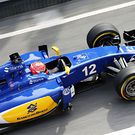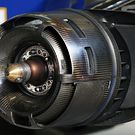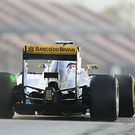Technical analysis: Sauber C34
After a woeful 2014 campaign (first ever season in the top flight with no points), Sauber hope their new C34 challenger will fare a bit better. The Sauber C33 lacked in engine power as well as its aero, typically a strength of the Hinwill based team thanks to its facilities in Switzerland. The C34 is a evolution of the C33 in an attempt to return as a midfield contender by fixing the aerodynamic issues.
Ferrari meanwhile attempts to take care of the engine and ERS side of things while the team also continues to use the Ferrari quick-shift gearbox in its provided carbon fibre casing. Sauber's Chief Designer Eric Gandelin noted that the Ferrari powerunit "very comparable to last year's, but its architecture has changed significantly, necessitating numerous adjustments to the chassis".
Looking at the C34 The biggest change is the front nose cone structure. Its mandatory that all teams comply with a 9000mm² cross section 5cm behind the very tip of the nose 20000mm² cross section forming where the nose touches the chassis.

What Sauber have done to meet the crash structure regulations is to fit a rather thick thumb section to the front of the nose. The slightly longer nose than the minimum as per the regulations gave the team an easier task designing the front impact structure, while the thumb section attempts to be as narrow as possible to create less of a hindrance to airflow.
At the top of the vanity panel you can see how the top of the chassis is blended to then meet the nose cone structure. This is to get a clearer exit of the airflow to the y100 winglet (monkey seat) as well as the rear wing, aiding in rear downforce.
The Sauber also features front wing pylons that appear fairly far apart from each other, aimed at diverting air onto the turning vanes attached on the underside of the chassis, above the T-tray. All this is done to clean airflow onto the underfloor and the sidepods and should benefit a lot with rear downforce on the car.
On the front wing side of things, it looks very neat. They still have the outboard Canard on the endplate which drags the airflow of the wheel wake. The Canard will make a pressure gradient where the low pressure air will be pulled out to then run on the outside of the car. This would be a cooling element where downforce is also gained. On the Cascade they have this turning vane which turns the flow outside of the wheel wake also. They still have the three mainplanes for their up wash effect.
Looking at the central section of the car they have large sidepod inlets for better cooling. As the Ferrari power unit is a very hot at its operating temperature. Likewise to the Ferrari SF15-T they have the “L” shaped vertical turning vanes. This is for the same concept as Ferrari which collects the air flow and y250 vortex to then feed it to the y100 winglet and rear wing.
Also Sauber seem to have very small wing mirrors. This is an object where a lot of air hits, so the smaller the surface area the more aerodynamic it will be, which is what Sauber have applied here on the C34.
 Sauber has also retained its rather unique roll hoop design. It’s a undercut structure which is made up of four elements (vanes). This pulls more air outbound of the car to the rear wing. It’s a feature on all Sauber cars since the Sauber C30 of 2011, designed by James Key. It is designed to help with rear downforce of the car. Its machined from a single block of Aluminium compared to some teams Titanium idea.
Sauber has also retained its rather unique roll hoop design. It’s a undercut structure which is made up of four elements (vanes). This pulls more air outbound of the car to the rear wing. It’s a feature on all Sauber cars since the Sauber C30 of 2011, designed by James Key. It is designed to help with rear downforce of the car. Its machined from a single block of Aluminium compared to some teams Titanium idea.
Looking at the rear of the car you can see the “swan neck” rear monkey seat pylon. This tells us that Sauber have a detailed y100 winglet and do not want others teams to see, at this moment in time.
On the rear wing its has a much less aggressive slope in the inner edge of the endplate. Its normally straight cut edges but Sauber seem to have a nice sloping concept on the C34.
Also on the rear, Sauber has not gone for the Ferrari rear suspension. And instead gone for their own, entirely new design with separate lower wishbones. This is because the 2014 car the C33 had very bad traction. So with their own geometry and suspension design they are able to have more freedom and improve the rear of the car.
While still using the Ferrari gearbox, the team also claimed to have optimised gear ratios to further help improve traction.

Overall the Sauber C34 looks a very neat package. The car looks to be a lot sleeker with some low drag downforce generators on the car. If the Ferrari power unit is strong. It should be a good season for Sauber if their Ferrari power unit is packed well.






